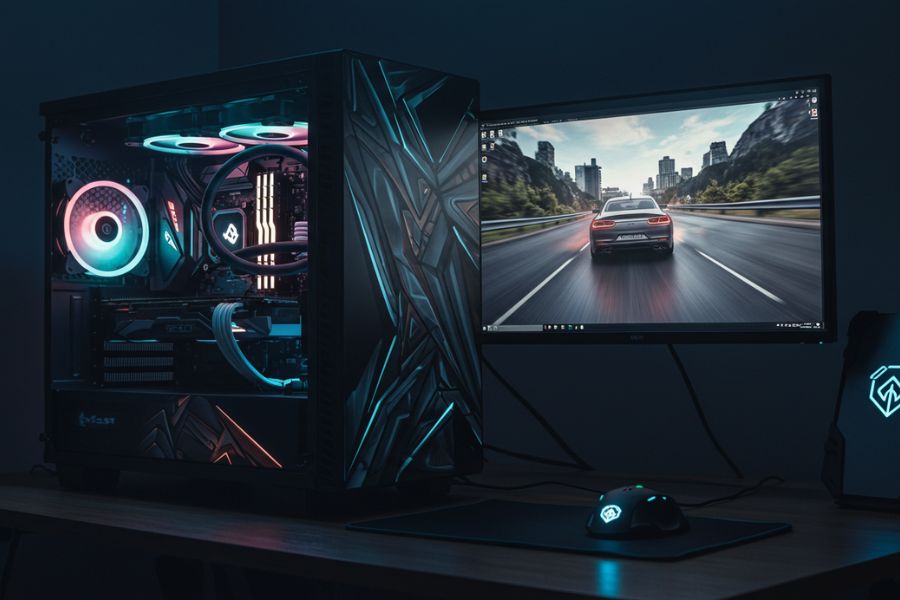Streaming gameplay demands significant resources. Unlike solo gaming, it requires running the game, capturing video, encoding it live, and managing overlays simultaneously. Without optimization, this multitasking causes frame drops, stutter, or poor stream quality. This guide details professional methods for how to optimize a gaming PC for streaming, ensuring a smooth experience for both the broadcaster and the audience.
Hardware: The Core Foundation
Your hardware underpins a stable stream. Both the central processing unit (CPU) and graphics processing unit (GPU) face heavy demands.
- CPU Power: For single-PC streaming, a high-core-count CPU is essential. Modern games use multiple cores, and encoding (especially software x264) is CPU-intensive. Target an Intel Core i7/i9 (12th Gen or newer) or AMD Ryzen 7/9 (5000 series or newer).
- GPU Capability: A strong GPU is crucial for high-fidelity gaming. Critically, modern NVIDIA RTX (GTX 1650 Super+) and AMD Radeon RX (5000 series+) GPUs feature dedicated hardware encoders (NVENC, AMF/VCE). These offload video compression from the CPU, dramatically boosting performance. A higher-tier GPU offers more headroom for high resolutions and frame rates while encoding.
- Sufficient RAM: 16GB is the absolute minimum. For a robust streaming and gaming PC setup, 32 GB of high-speed DDR4/DDR5 RAM is strongly recommended. This prevents slowdowns when running the game, streaming software, the browser, and background apps.
- Fast Storage: Use an NVMe SSD for your OS, games, and streaming software. This reduces load times and improves asset streaming. A secondary SSD/HDD is ideal for recordings.
- Stable Network: A wired Ethernet connection is mandatory. Wi-Fi introduces latency and packet loss. Ensure sufficient upload bandwidth. For 1080p 60fps, a consistent 10 Mbps upload is recommended as a minimum; more provides headroom.
Software & Streaming App Configuration
Proper software setup is critical for maximizing streaming PC performance tips and improving stream quality on PC.
-
Operating System:
- Keep the OS and drivers (GPU, chipset, network) fully updated.
- Set Windows Power Plan to High Performance.
- Disable non-essential startup programs and background services using Task Manager. Silence notifications.
- Ensure Windows Game Mode is enabled to suspend background tasks during gameplay.
-
Streaming Software (OBS Studio Preferred):
- Run as Administrator: Grants higher resource priority, improving stability.
- Encoder Choice (Critical):
- Hardware Encoders (NVENC/AMF): Strongly recommended for single-PC setups. They use the GPU’s dedicated encoder, minimizing impact on the game and CPU. Quality rivals software encoding on newer GPUs.
- Software Encoder (x264): Only viable with very high-core-count CPUs and less demanding games. Otherwise, it severely impacts performance.
- Encoder Settings:
- Rate Control: Use CBR (Constant Bitrate).
- Bitrate: Match your stable upload speed and platform limits. For 1080p60, 6000-8000 Kbps is common. Never exceed ~80% of your upload.
- Preset: For NVENC, use Quality. Avoid Max Quality. For AMD, use Quality or Balanced. Enable Look-ahead and Psycho Visual Tuning on NVIDIA if available.
- Resolution: Set Base (Canvas) to your monitor’s native res. Set Output (Scaled) to your stream resolution (e.g., 1920×1080). Use Lanczos scaling.
- Frame Rate: 60 fps for smooth motion if supported; 30 fps is acceptable otherwise.
- Sources: Optimize scenes. Disable unused sources. Monitor resource use of browser sources (alerts, chat).
In-Game Performance Tuning
Balance visuals and performance for streaming.
- Frame rate cap: You want to cap the in-game FPS frame rate slightly below the monitor’s max refresh rate (like 141 fps for a 144 Hz monitor). This will reduce GPU power usage and run cooler, giving the GPU more resources to focus on encoding while also giving a more consistent frame rate over time.
- Reduce GPU-Intensive Settings: Lower settings that tax the GPU to free encoding headroom. Prioritize Shadows, Anti-Aliasing (use TAA/FXAA), Ambient Occlusion, View Distance (moderately), and demanding effects like Motion Blur or Depth of Field.
- Reduce CPU-Intensive Settings: If using x264 or playing CPU-heavy games, lower settings like Physics or NPC Density.
Advanced Streaming PC Performance Tips
- Dual-PC Setup: The ultimate solution. One PC runs the game; the other handles capture and encoding via a capture card. Eliminates single-PC resource conflicts.
- Separate Audio: Use a dedicated USB microphone. Consider an audio interface for superior mixing control in OBS.
- Thermal Management: Streaming stresses components for hours. Ensure excellent case airflow. Clean dust filters. Monitor CPU/GPU temps. Thermal throttling cripples performance. Advanced users can explore undervolting.
- Browser Optimization: Disable hardware acceleration in background browsers (chat/dashboard) to prevent GPU resource competition.
Conclusion:
Mastering how to optimize a gaming PC for streaming requires a methodical approach. Start with capable hardware, emphasizing CPU cores and a GPU with a strong hardware encoder. Meticulously configure your OS and streaming app, prioritizing NVENC or AMF encoding.
Tune game settings for stable FPS, and prioritize a wired, high-bandwidth connection. Applying these professional streaming and gaming PC setup principles and streaming PC performance tips will significantly improve stream quality on PC, delivering a polished, reliable broadcast that captivates your audience. Test and adjust settings based on your specific hardware and games.
